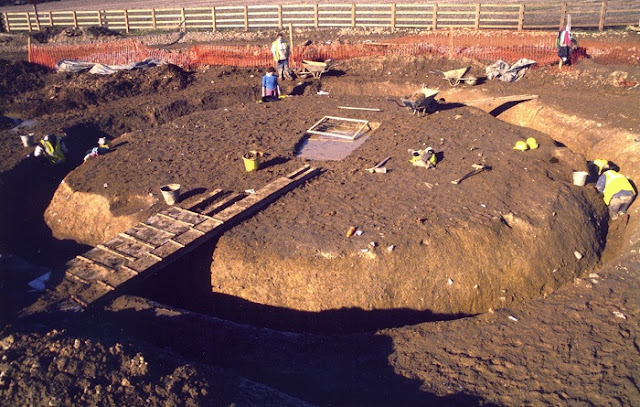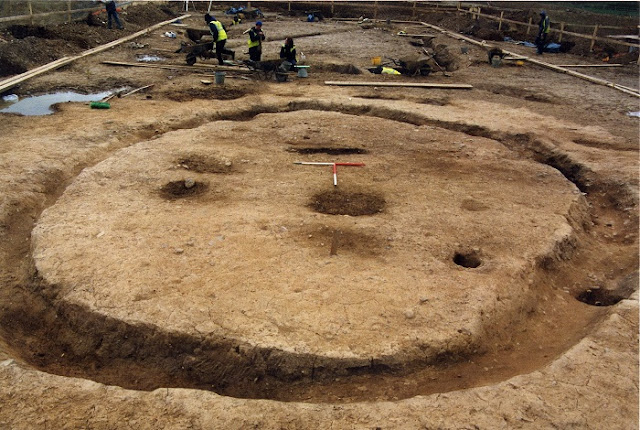Archaeological Archives for Sale! Buy it or bin it!
For Sale!
Offers Above: £10,000
Collection Only. Sold as is. No Time-wasters.
Offered: The surviving archives of six archaeological sites excavated between July 2000 and February 2002 on the Northern Motorway, near Drogheda, Co. Louth and on the Airport-Balbriggan Bypass, Co. Dublin.
As there is little chance that any of this material will ever be published, I have taken the difficult decision to put these archives on the open market to recoup some of the costs of storage incurred in keeping them safe for the best part of two decades.
The archives are composed of the majority of the excavated finds, charcoal from sieved samples, permatrace field drawings, photographic archive, and the incomplete final reports for three sites. The latter include some (but not all) of the specialist reports necessary to bring the sites to completion. In particular, there are no radiocarbon dates available for all but one site. Given the age of the excavations and how much scholarship has moved on in the intervening years, the written interpretations and conclusions are likely to be wildly out of date and in need of a complete reassessment.
Offer will remain open until July 11 2019, after which time the digital archives will be deleted and all physical materials either dumped or sorted for pieces which may be sold individually.
 |
| Ditch at Balgatheran 1 under excavation 2000 |
 |
| Hearth in ditch at Balgatheran 1 2000 |
Balgatheran 1 (00E0477), Co. Louth, was a multi-period site that produced evidence from various eras, including the prehistoric, Early Christian, and medieval. The most significant features uncovered were all of Early Christian date and included a large ditch, a possible workshop, and a cereal drying kiln. It was excavated from 11 July 20 November 2000. [Excavations.ie | Preliminary Report: Part I, Part II, Part III]
 |
| Mell 2 post-excavation 2001 |
Mell 2 (00E0430), Co. Louth, was an interesting combination of a ring-ditch and a unique form of elongated ditched enclosure. The lower fills of the ditched enclosure were sterile redeposited natural, but the upper layers were rich in charcoal, fire-cracked stone, and cremated bone of both human and animal origin. It was excavated from 23 February to 11 May 2001. [Excavations.ie | Preliminary Report]
 |
| Mell 2 Ditched enclosure post-excavation 2001 |
 |
| Sieved charcoal samples from Mell 2 in storage |
 |
| Decorated bead from Mell 2 |
Tullyallen 1 (00E0429), Co. Louth, was a large ring barrow with a central cremation burial. It was excavated from 4 December 2000 to 21 February 2001. The central burial was raised in a block for off-site excavation and conservation, and is not part of the archive. [Excavations.ie | Preliminary Report]
 |
| Tullyallen 1 during excavation 2001 |
Newtown-Monasterboice 4 (00E0479), Co. Louth, was a small collection of pits and post-holes. It was excavated between 3 and 10 July 2000. [Excavations.ie | Final Report]
Ballough 17 (02E0078), Co. Dublin, was a collection of prehistoric pits and a Medieval field ditch. The site was excavated between 14 January and 26 February 2002. [Excavations.ie | Preliminary Report]
 |
| Ballough 23 during excavation 2002 |
Ballough 23 (01E1138), Co. Dublin, was a probable burnt mound. It was excavated from 19 November 2001 to 11 January 2002. [Excavations.ie | Preliminary Report]
* * *
Consolidated finds lists: *
Balgatheran 1
6 items of glass, including three beads
83 items of bone & teeth, including both burnt & unburnt as well as both human and animal material
559 items of flint, 8 scrapers/possible scrapers, 69 struck/worked pieces, 1 core, & 333 pieces of débitage etc.
83 pottery sherds, mostly coarse, prehistoric + later material
76 pieces of iron/metal, including 70 items of iron slag etc.
As well as several items of stone & 14 pieces of clay pipe
 |
| Possible workshop (Structure I), Balgatheran 1 2000 |
Mell 2
One decorated glass bead
77 bags of bone & teeth (mostly burnt, mostly human)
251 flint & chert items, including two scrapers, 106 struck pieces, 17 worked pieces, three cores, 34 pieces of débitage, 34 burnt pieces etc.
45 pieces of pottery, the majority of which has been tentatively identified as Bronze Age
1 piece of polished porcellanite
12 pieces of metal slag
 |
| Mell 2 Glass bead in storage box. Labels are weathering & starting to fall off |
Tullyallen 1
One glass bead
13 bags of burnt bone
25 pieces of flint/chert, including one scraper, 6 pieces of débitage, & six burnt pieces
Three pieces of pottery
Two pieces of metallic slag, and six pieces of quartz
 |
| Tullyallen 1 post-excavation 2001 |
Newtown-Monasterboice 4
3 pieces of flint – 1 each of a scraper, a piece of débitage, and a piece of struck flint
1 burnt stone
1 piece of ferrous slag
Ballough 17 **
Mostly medieval pottery
 |
| Ballough 23 during excavation 2002 |
Ballough 23 **
Mostly flint, with some pottery (mostly medieval, but occasional pieces of prehistoric pottery too) as well as both burnt & unburnt bone
* * *
The serious point underlying this post is that a large number of archaeological archives are retained by excavation directors, frequently long after the expiration of any chance of funding for publication, or even after the liquidation of the commissioning Consultancies. The government bodies charged with the care of these cultural resources are overstretched and under-resourced and have relied on the good will and kindness of individual archaeologists to curate and preserve these archives. Inevitably, as this generation of field archaeologists age, retire, and expire, these archives are placed in peril. Some spouse, partner, or colleague may make an attempt to see that any archives residing under the eaves are passed on to the licencing authorities or some other group or individual. However, I believe that the majority will be dumped by relatives looking to clear house and that many of these archives will simply end up in landfill.
 |
| Archive box from Balgatheran 1. Might be slag ... might be bone ... who knows? |
It’ll happen quietly.
There will be no ceremony or public outcry.
Perhaps the occasional researcher or student will wonder ‘whatever happened to the finds from X?’.
The few that do know the story will sigh and shrug their shoulders.
Archives lost.
Knowledge erased.
Our shared cultural heritage eroded.
It’s not really a big deal, is it?
 |
| Mell 2 ring-barrow post-excavation 2001 |
It's common knowledge in field archaeology that this happens. It's also common that we don't say much about it or cause a fuss. Frequently, this is because individuals are keen not to compromise their careers by making waves. Some may hold out the hope (however forlorn) that one day there will be funding. Maybe they'll find the time to tackle it in retirement. Undoubtedly, all of us have a love of the archives we've helped create and want to see the best for them. I too, at various times, have belonged to all of these categories. The difference in this instance is that I’m standing up and saying that I’ve had enough of providing free curation. Instead, I’m setting a remarkably reasonable price for almost two decades of storage. I’m also setting a deadline for when that material will be disposed of. If it’s important and you want it, it’s time to pay for it. Either way, it's time to stop relying on private individuals to keep this material in long term storage on behalf of companies and institutions that do not appear to care.
 |
| Cereal drying kiln, post excavation Balgatheran 1 2000 |
Notes
* These are illustrative only, as some materials may have become separated from the archives and ended up in storage elsewhere, lost, or dumped.
 |
| Mell 2 & Tullyallen 1 post-excavation 2001 |
** I ran out of patience and only quickly perused the finds lists for the two Ballough sites
 |
| Stacked piles of archive material gathering dust |






As I understand it, and from a source that said she wasn't really be telling me, if you were to dump this on the NMI's door step it would be looked after. But I do get your point.
ReplyDeleteSpot on Robert
ReplyDeleteInteresting and nice to see that academia is a much a hotbed of stupidity as the rest of the universe. Tis is how things roll throughout society. Nobody comments because they are all hoping for career advancement.....Well done and great article.
ReplyDelete